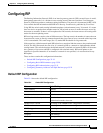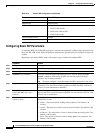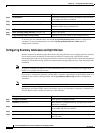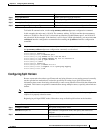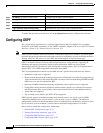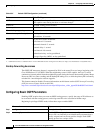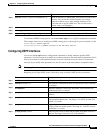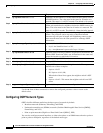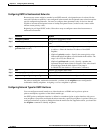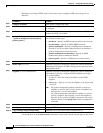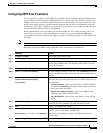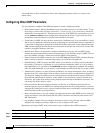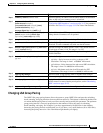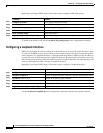
35-27
Cisco ME 3400 Ethernet Access Switch Software Configuration Guide
OL-9639-06
Chapter 35 Configuring IP Unicast Routing
Configuring OSPF
To terminate an OSPF routing process, use the no router ospf process-id global configuration command.
This example shows how to configure an OSPF routing process and assign it a process number of 109:
Switch(config)# router ospf 109
Switch(config-router)# network 131.108.0.0 255.255.255.0 area 24
Configuring OSPF Interfaces
You can use the ip ospf interface configuration commands to modify interface-specific OSPF
parameters. You are not required to modify any of these parameters, but some interface parameters (hello
interval, dead interval, and authentication key) must be consistent across all routers in an attached
network. If you modify these parameters, be sure all routers in the network have compatible values.
Note The ip ospf interface configuration commands are all optional.
Beginning in privileged EXEC mode, follow these steps to modify OSPF interface parameters:
Step 3
network address wildcard-mask area area-id Define an interface on which OSPF runs and the area ID for that
interface. You can use the wildcard-mask to use a single
command to define one or more multiple interfaces to be
associated with a specific OSPF area. The area ID can be a
decimal value or an IP address.
Step 4
end Return to privileged EXEC mode.
Step 5
show ip protocols Verify your entries.
Step 6
copy running-config startup-config (Optional) Save your entries in the configuration file.
Command Purpose
Command Purpose
Step 1
configure terminal Enter global configuration mode.
Step 2
interface interface-id Enter interface configuration mode, and specify the Layer 3 interface
to configure.
Step 3
no shutdown Enable the interface if necessary. By default, UNIs and ENIs are
disabled and NNIs are enabled.
Step 4
ip ospf cost (Optional) Explicitly specify the cost of sending a packet on the
interface.
Step 5
ip ospf retransmit-interval seconds (Optional) Specify the number of seconds between link state
advertisement transmissions. The range is 1 to 65535 seconds. The
default is 5
seconds.
Step 6
ip ospf transmit-delay seconds (Optional) Set the estimated number of seconds to wait before
sending a link state update packet. The range is 1 to 65535 seconds.
The default is 1 second.
Step 7
ip ospf priority number (Optional) Set priority to help find the OSPF designated router for a
network. The range is from 0 to 255. The default is 1.



